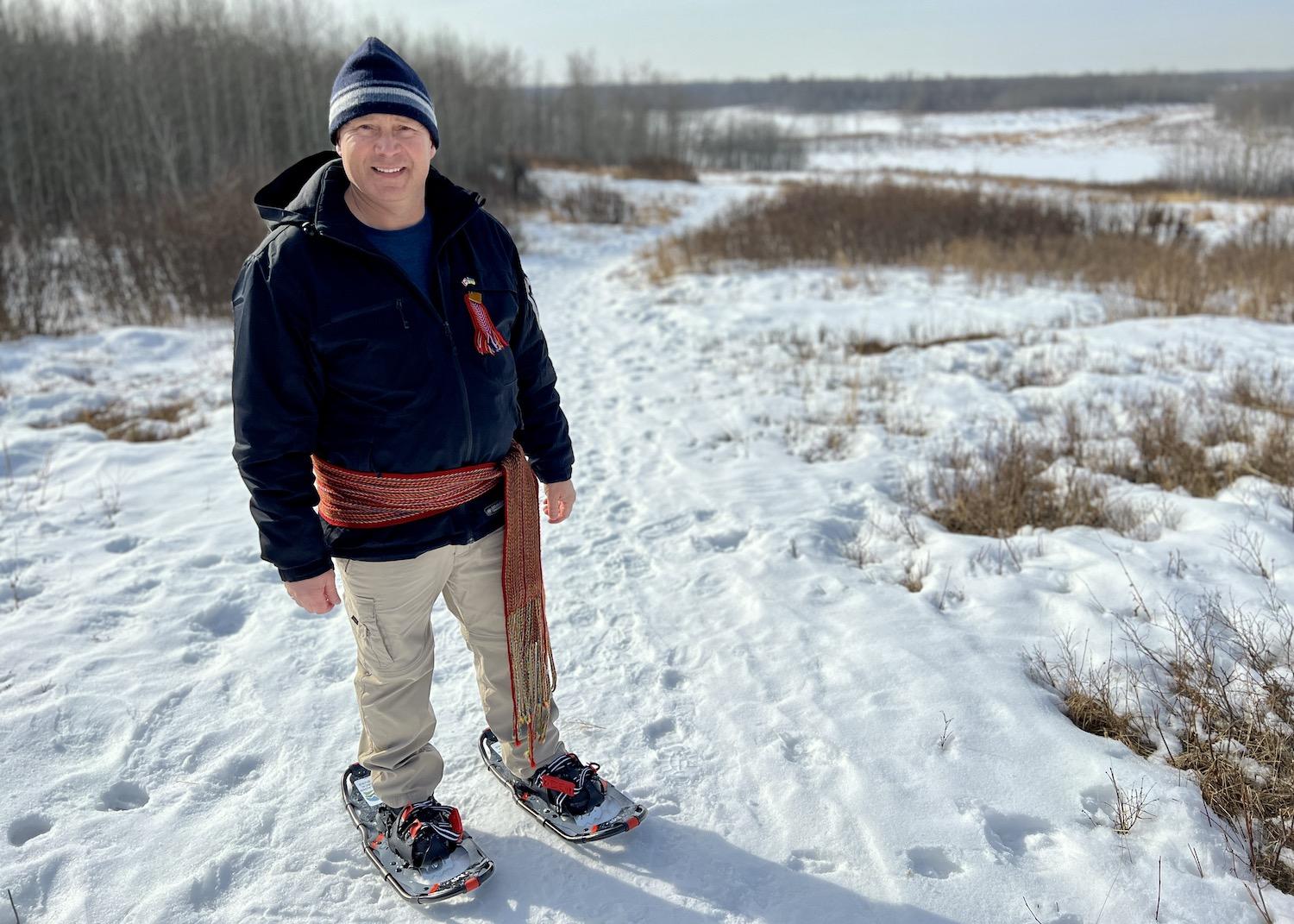
Keith Diakiw, a Métis geologist who founded Talking Rock Tours, leads a guided snowshoe trip through Elk Island National Park in Alberta wearing a Métis sash/Jennifer Bain
Keith Diakiw deftly wraps a red-striped Métis sash over my winter coat and around my waist, tying it loosely on the left to signify that I’m taken and not single. One of my fellow “geo-explorers” opts to have her sash tied in the middle as a hard-working Voyageur would have during the fur trade era. Another chooses to be a Métis princess with the sash wrapped over her left shoulder across her heart.
“Today I’d like to make you an honorary Métis as we journey through this beautiful boreal forest at Moss Lake,” the founder of Talking Rock Tours says as we prepare to snowshoe through Elk Island National Park in central Alberta.
“You see, traditionally it was more just for the men and it was more than just keeping your pants up. It was literally like a carpenter’s work pouch, right, because the more you wrapped it around you kind of made different pockets for holding your pemmican, your bone needle and certain things.”
Diakiw — the direct descendant of a Métis war hero from Saskatchewan — wears his sash to bring his ancestors on each and every tour. His fourth-great grandfather Joseph Ouellette Sr. fought alongside Métis leader Louis Riel and Gabriel Dumont at the Battle of Batoche during the North-West Resistance in 1885. Ouellette was killed on the last day of battle at the age of 93 fighting for his way of life and culture.
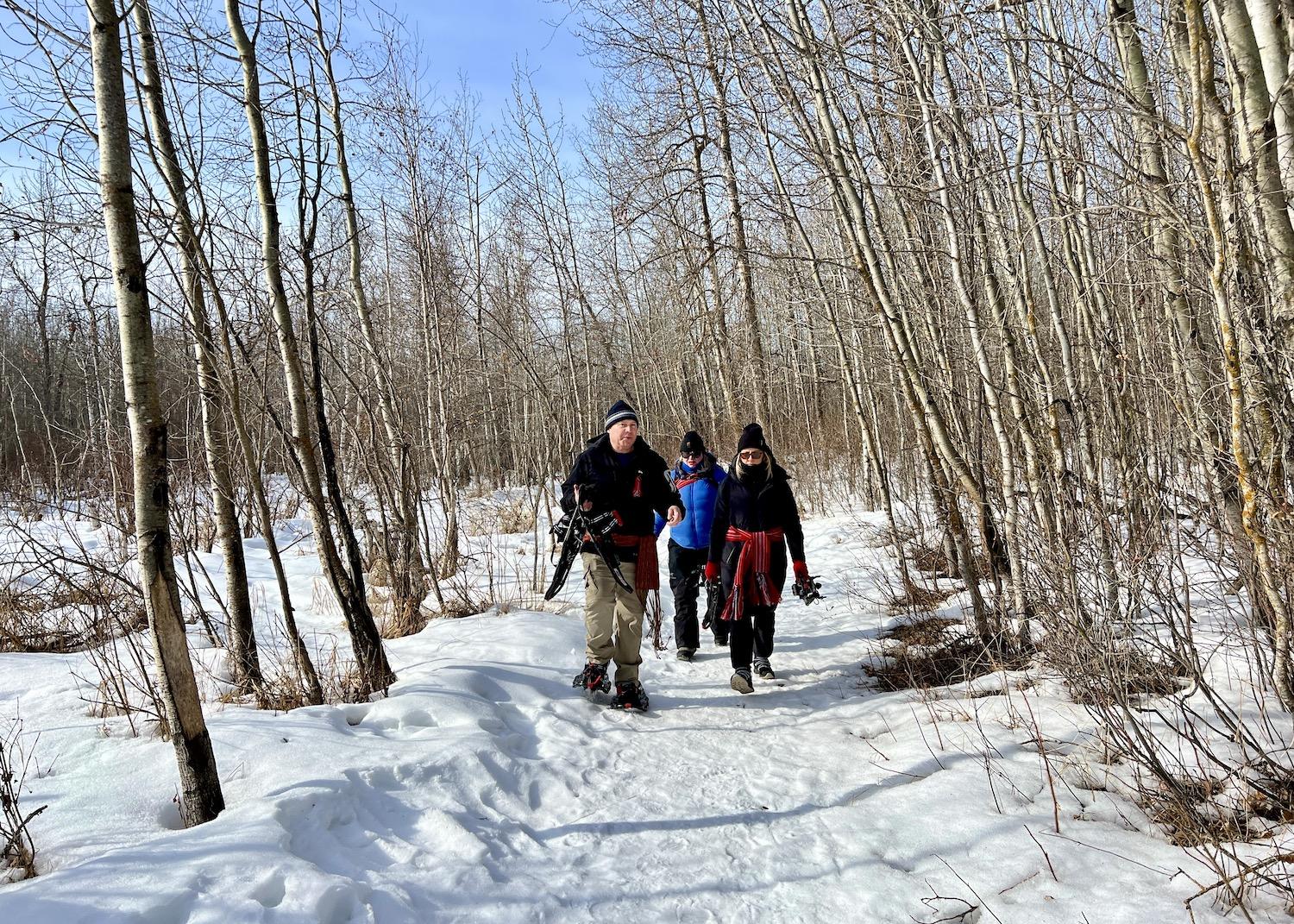
Talking Rock Tours founder Keith Diakiw leads a small group through Elk Island National Park/Jennifer Bain
Diakiw’s sash was made by a Métis artist and sold at the Batoche National Historic Site gift shop in Saskatchewan. Ours are the official sashes of the Métis Nation of Alberta. Each color has a different meaning. For example, red signifies bloodshed, Diakiw explains, and blue symbolizes resilience.
First used by the Voyageurs of the fur trade and quickly adopted by their Métis sons, the sashes were traditionally 10-feet long and held coats closed, but doubled as tow ropes, tumplines, towels and even sewing kits. They remain an integral part of Métis culture and heritage.
In Canada, the Indigenous Peoples are First Nations, Métis or Inuit. Métis — according to the Métis Nation of Alberta — means a person who self-identifies as Métis, is distinct from other Indigenous peoples, is of historic Métis Nation ancestry, and who is accepted by the Métis Nation. The post-contact Indigenous nation was born from the unions of European fur traders and First Nations women in the 18th century. The descendants of these unions formed a distinct culture, and communities developed along fur trade routes that made the Métis Nation Homeland in what’s now Manitoba, Saskatchewan, Alberta, parts of British Columbia and Ontario, the Northwest Territories and the northern United States.
It's a lot to digest as we head out one Saturday in March with Diakiw, who also has French and Ukrainian heritage and calls himself a “double breed” who benefits from having both Indigenous and European world views.
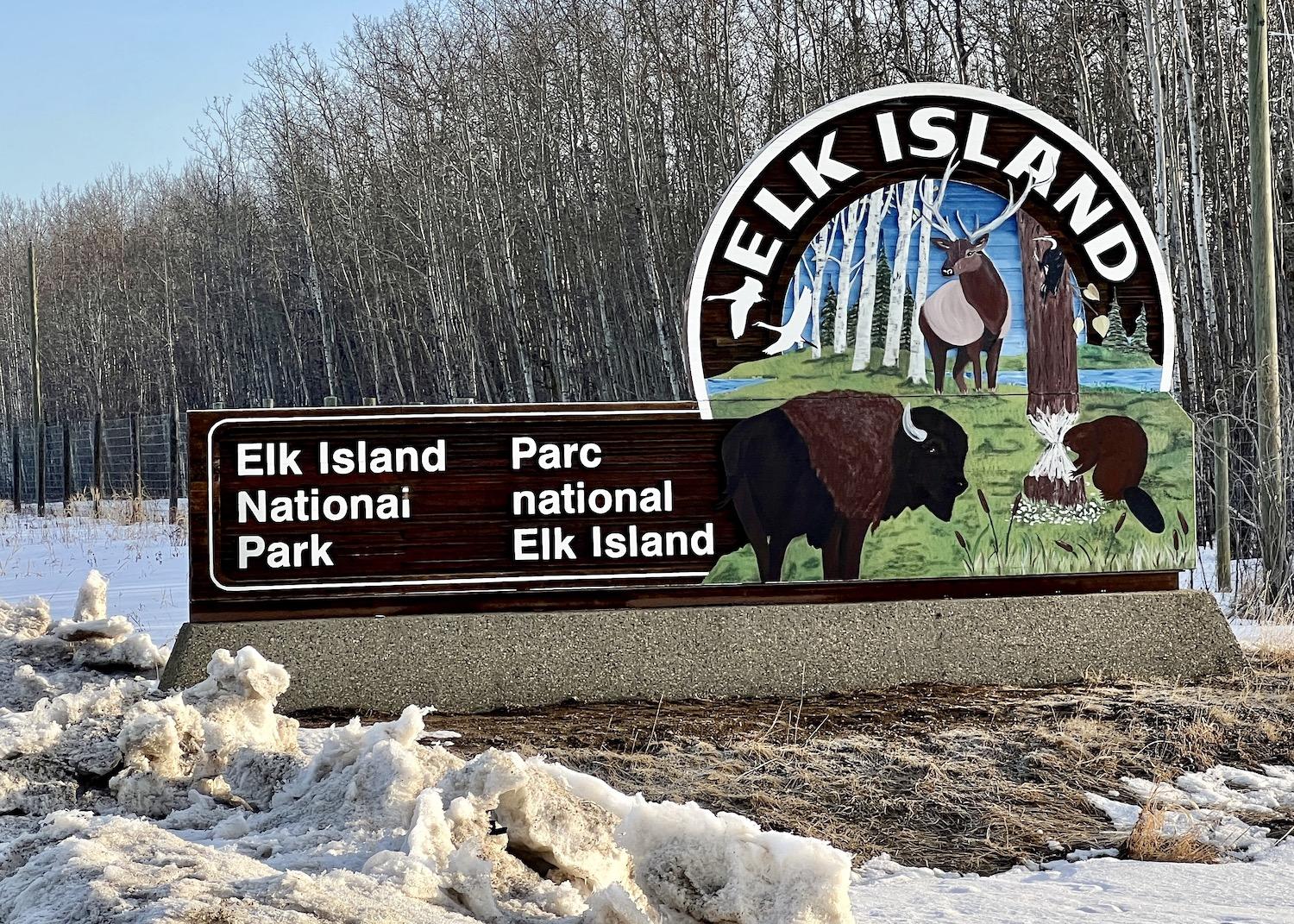
Don't let the name fool you. Elk Island National Park is mostly home to bison and it's rare to see the elusive elk/Jennifer Bain
A geologist by trade and former naval officer who is currently the northern environmental coordinator for the army, Diakiw embraced Indigenous tourism in 2017 and launched his company a year later. “I see it as reconciliation in action,” he says. The Truth and Reconciliation Commission of Canada defines reconciliation as an ongoing process of establishing and maintaining respectful relationships. Listening to and learning from the lived experiences of First Nations, Inuit and Métis in Canada is essential to advancing reconciliation.
Talking Rock Tours offers small group, earth science-focused hikes with an Indigenous lens in Elk Island, Edmonton, Nordegg and the Badlands. Last year to extend his season, Diakiw added winter trips to Elk Island, which is just 35 minutes east of Edmonton.
At just 74 square miles, Elk Island is the one of Canada’s smallest national parks and the only one that is fully fenced. Created as a wildlife sanctuary for elk in 1906, it became a national park in 1913. In 1943, the preservation of plains bison was designated as a national historic event, recognizing the park’s role in the history of wildlife conservation.
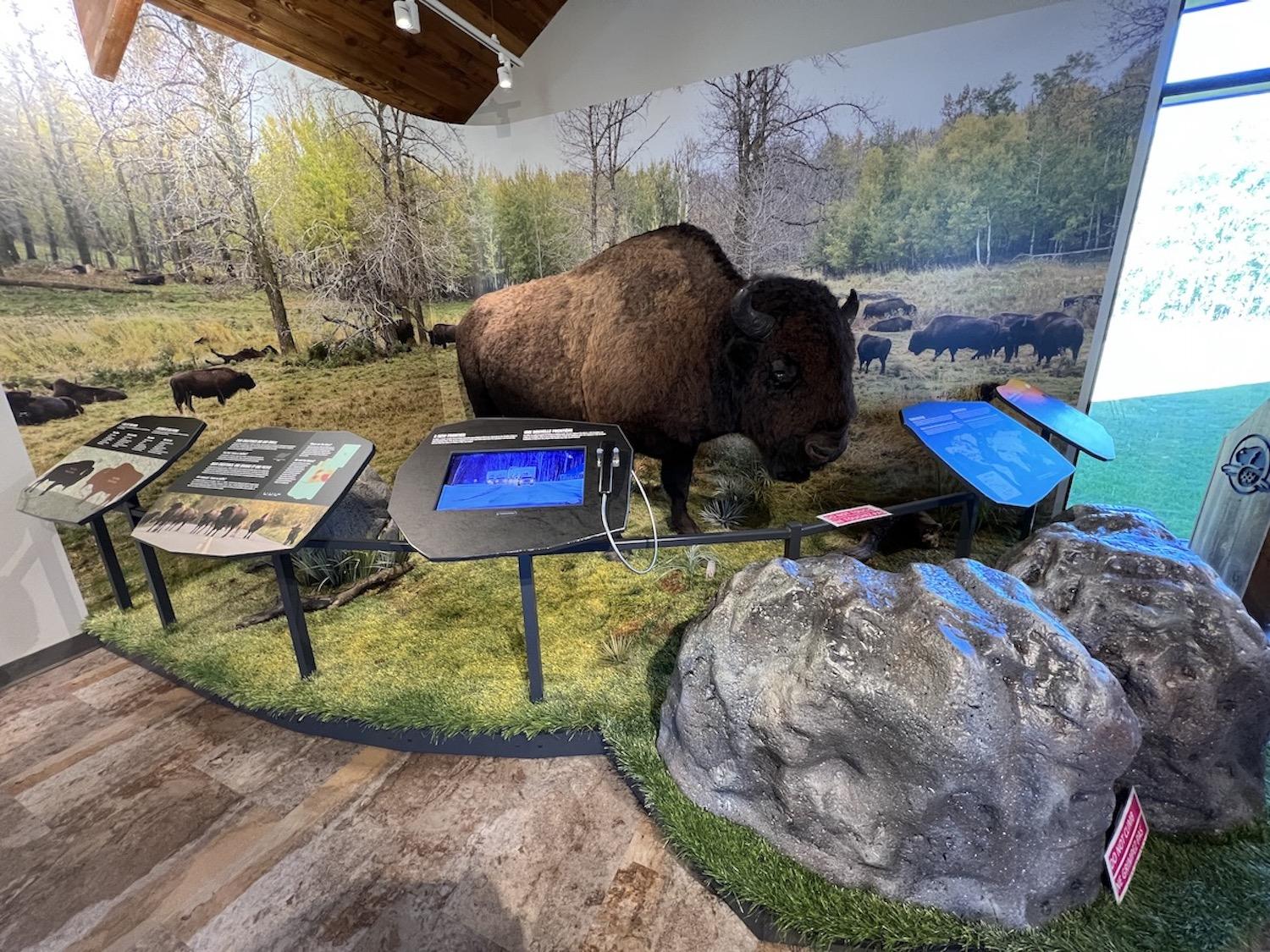
You can learn about bison inside the park's Wahkotowin Visitor Information Centre/Jennifer Bain
A fence splits the park into two blocks that are on either side of the four-lane Yellowhead Highway. The larger north block contains the plains bison herd, as well as the Wahkotowin Visitor Information Centre, campground and most of the trails. The south block contains the wood bison herd and one trail.
The park is in a transition area between the grasslands to the south and the boreal forest to the north. It’s located on the Beaver Hills plateau, known as Amiskwaciy (Beaver Hills) to Cree people. The plateau rises 65 feet above the surrounding plains and supports wetlands, aspen forest, grasslands and agricultural lands.
Elk Island is within Treaty 6 territory and the Métis Nation homeland and at least eight Indigenous communities have direct ties to the park lands. Oral histories also link Treaty 7 and Treaty 8 nations to the landscape.
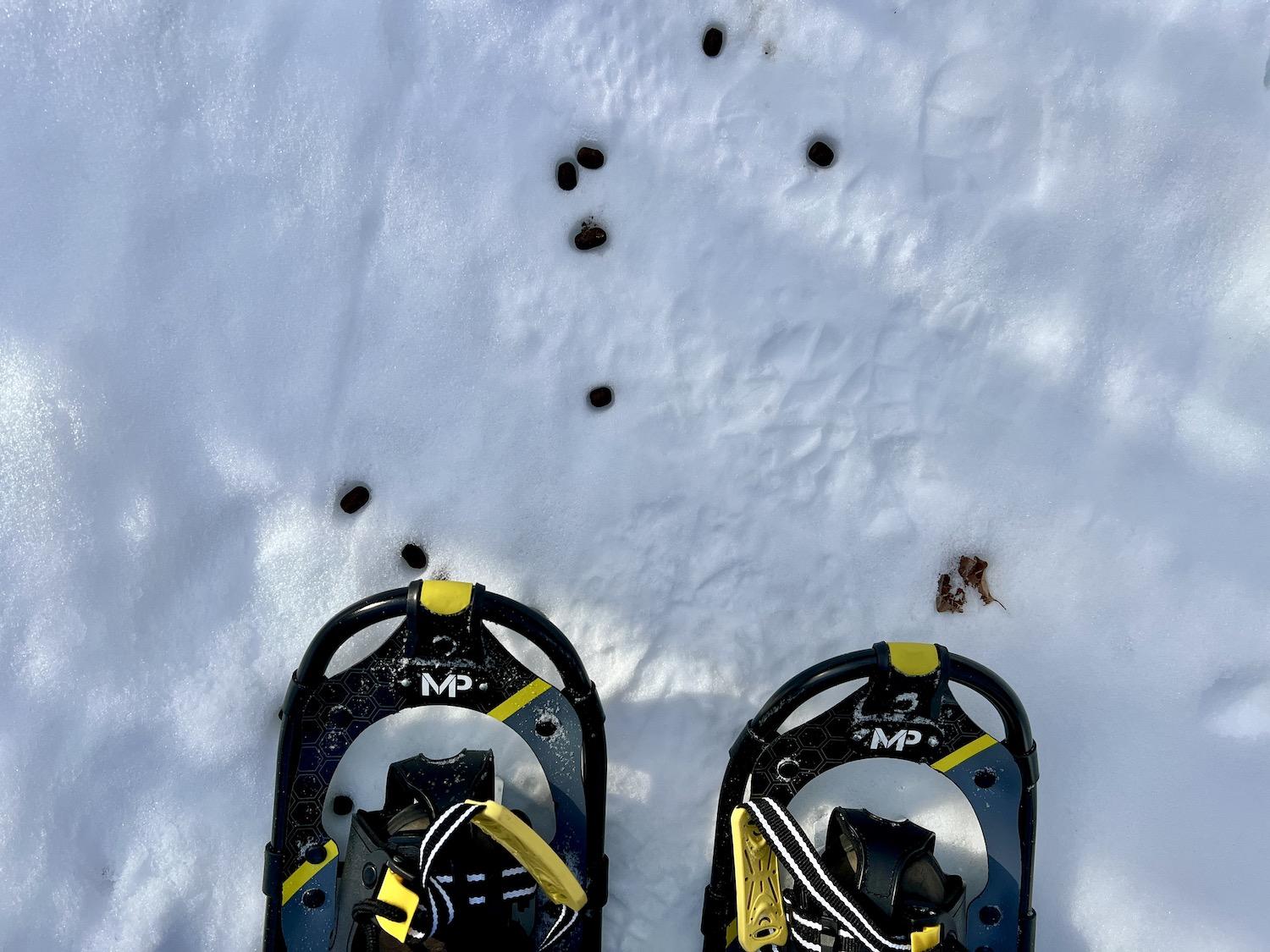
Signs of deer can be found while snowshoeing the Moss Lake Trail/Jennifer Bain
As we snowshoe down the popular Moss Lake Trail like the Métis once did, we don't readily spot wildlife but do hear a squirrel chattering and spot deer scat and what appears to be coyote scat.
Diakiw loves how this trail starts with boreal forest but then opens up to a meadow area where you can see "the terraced work of beaver dams.” During the pandemic, park staff created a shortcut so there is now a three-mile loop as well as the original eight-mile trail.
Diakiw stops to point out paper bark that makes “the best fire starter ever,” the malleable red willow that his ancestors used to make bows and arrows and baskets, and the black knot fungus that has infected parts of the forest. He takes a few moments to teach us about the last ice age and show off three rock samples. One is petrified wood, Alberta’s provincial stone and something he hopes to see honored on the next licence plate.
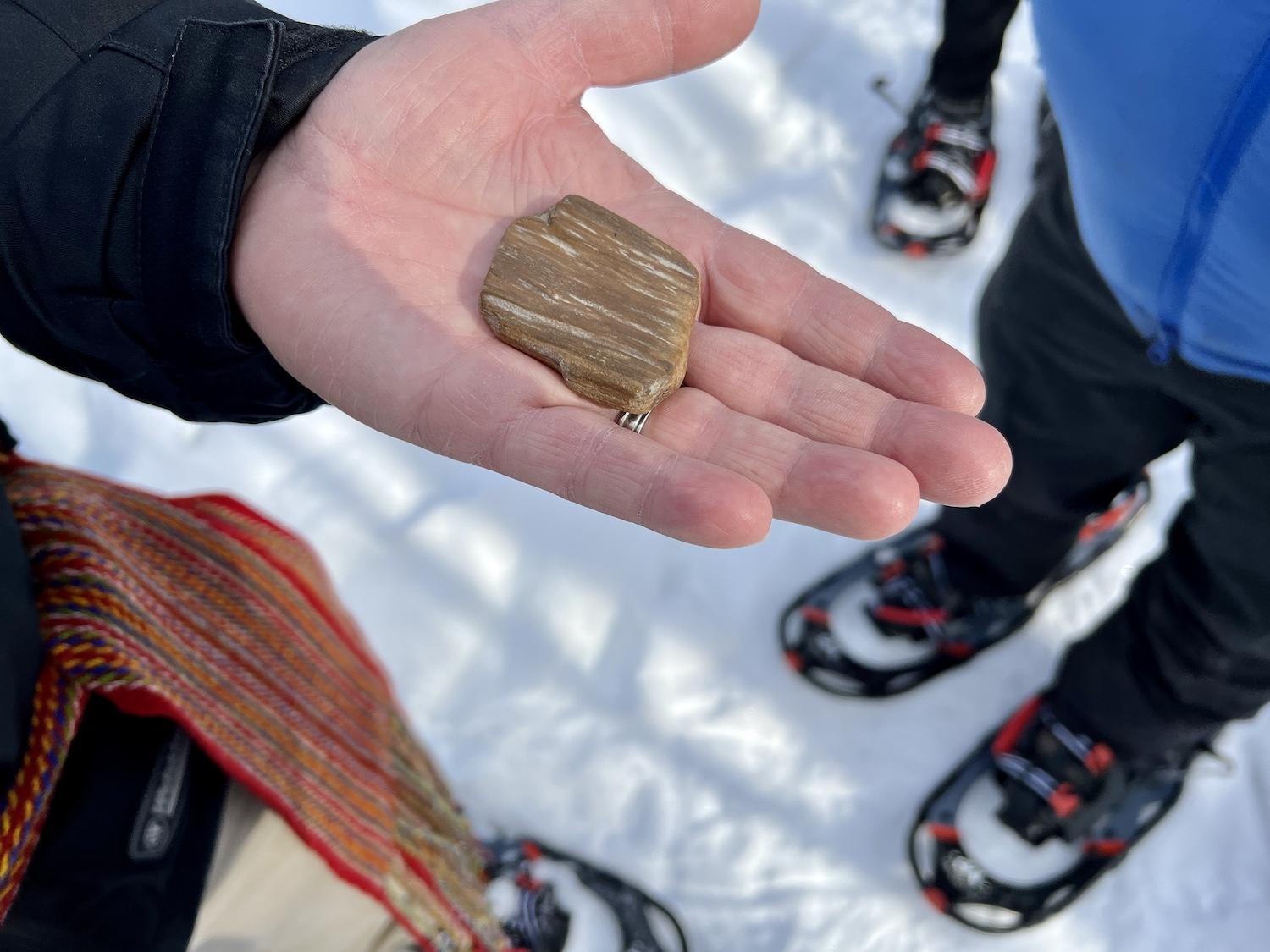
Talking Rock Tours founder Keith Diakiw, a geologist, shows off a piece of petrified wood/Jennifer Bain
Reaching into his pocket at one point, Diakiw pulls out a replica stone tool and a real fur trade token.
Trade tokens were the earliest currency used in the fur trade and were originally made of wood, ivory or shell and later of brass and aluminum. They had an assigned value and were given to trappers in exchange for furs. The trappers then swapped the tokens for goods and supplies carried at the trading post.
"The standard used to establish the unit of value was based on the contemporary value of beaver pelts — beaver being the most sought after and prevalent fur caught during the majority of the fur trade," the Manitoba government explains. The unit was equal to the value of an adult beaver pelt in prime condition and was called a Made Beaver. All trade goods were priced in terms of Made Beaver (MB).
We admire the fur trade token that Diakiw shows us, which says Hudson's Bay Company on one side and 5 M.B. on the other.
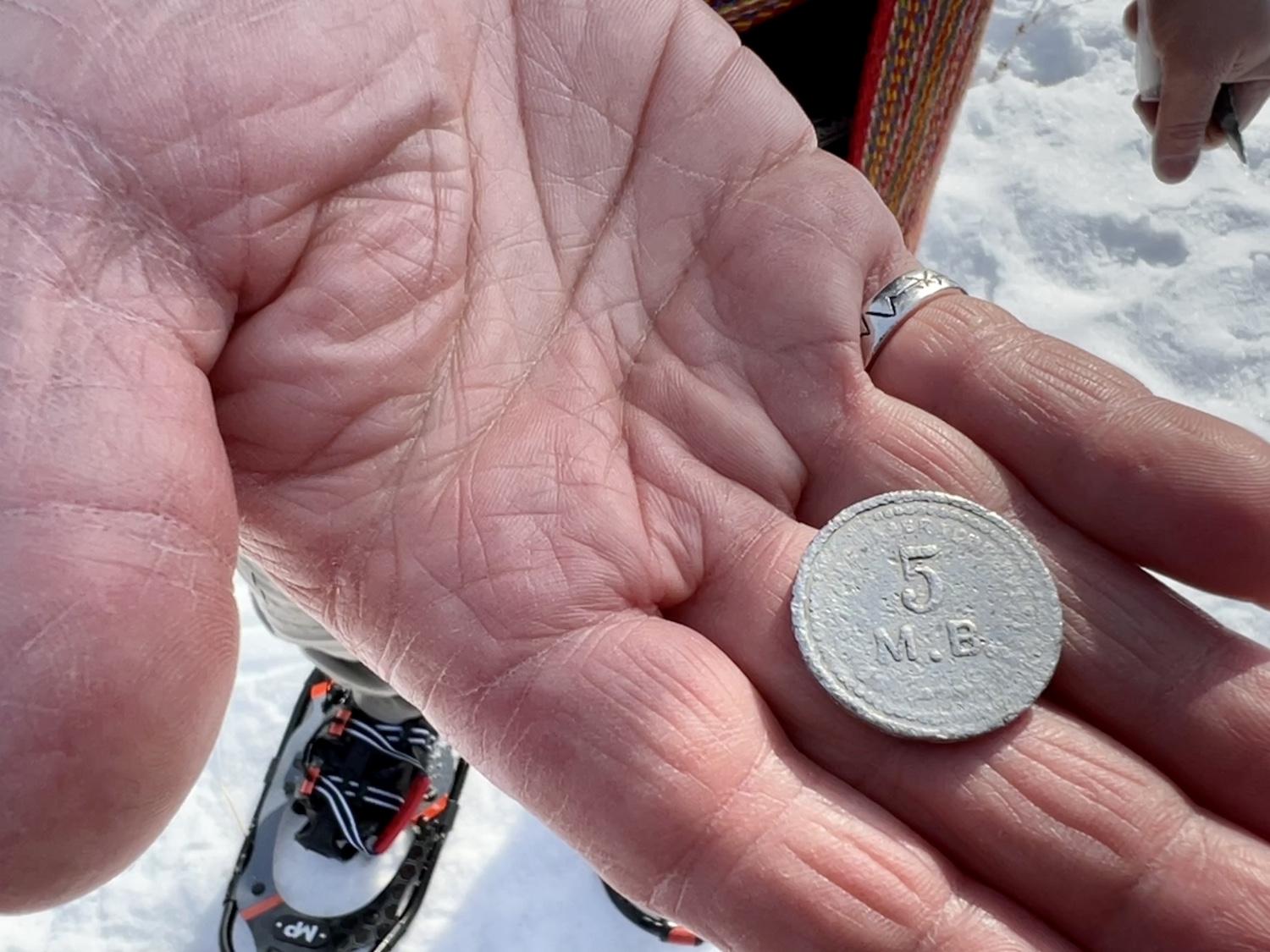
Fur trade tokens were assigned values based on the value of beaver pelts. M.B. stands for Made Beaver/Jennifer Bain
We are short on time — the tour usually takes at least 3.5 hours but we have somewhere else we have to be — but when the forest opens up to meadows we linger to try to catch a glimpse of terraced beaver ponds. Beavers were reintroduced to the park in 1941 after a 100-year absence.
We stand side by side for a tobacco ceremony to give thanks for utilizing Mother Earth and learn a few words in Michif (the language of the Métis), Cree, Stoney Nakoda and Ojibway. Before we reluctantly turn around to head back to our car, we see bison scat and an area where moose nibble on the willows. There are no bison around so we are grateful that we got a good look at a plains bison ambling down the park's main road on our way in.
At the end of our journey, we swap our borrowed Métis sashes for cups of tea from Edmonton-based, Indigenous-owned Mother Earth Essentials. The herbal blend that Diakiw has chosen is called Balance and it's a mix of raspberry leaf, sage leaves and rose petals. Presumably he likes the taste and not, as the company website explains, the fact that it's "a lovely blend for balancing hormones, especially during your moontime."
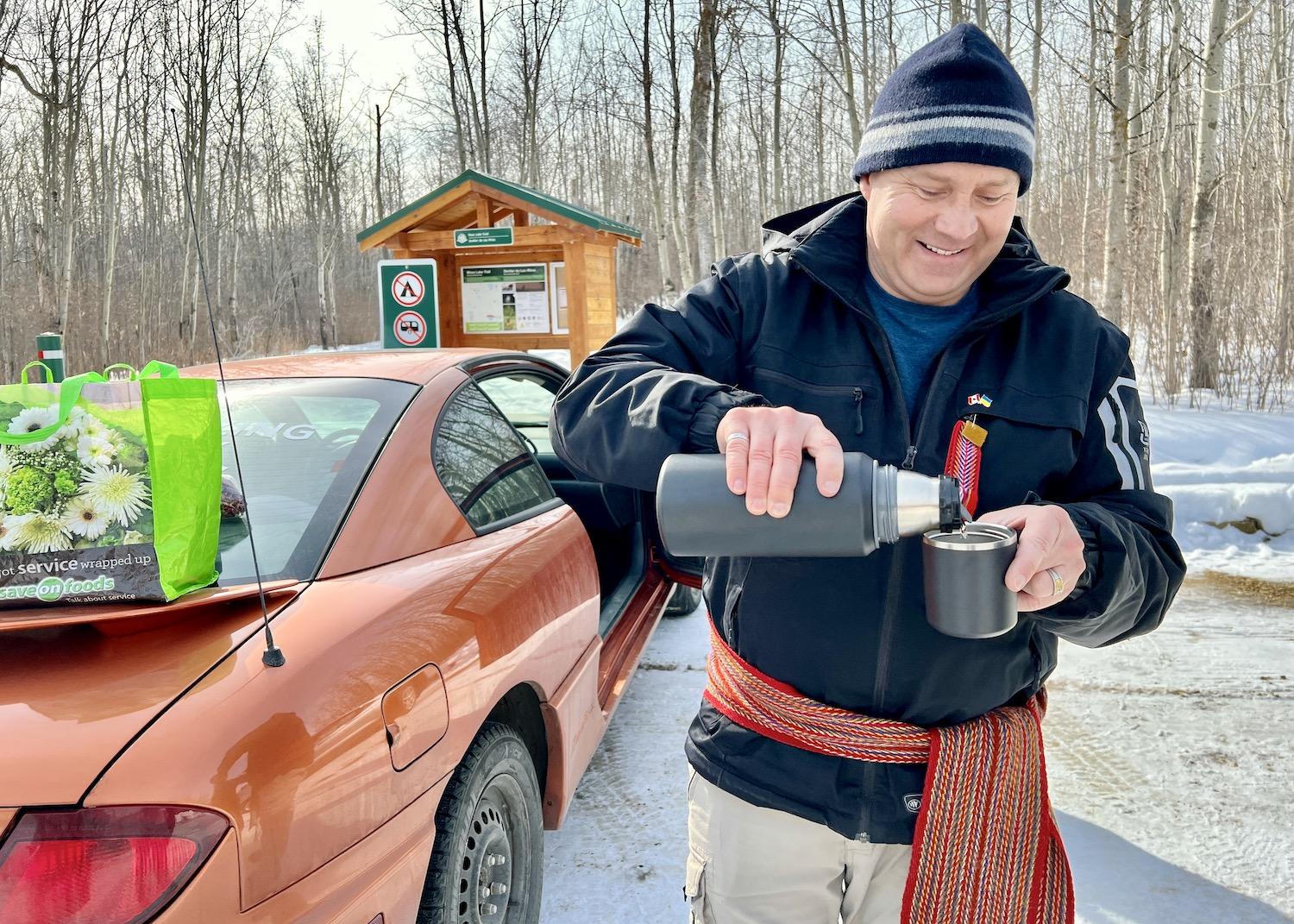
Keith Diakiw ends each Talking Rock Tour with tea from an Indigenous-owned, Edmonton-based company/Jennifer Bain
Elk Island is an easy day trip from Edmonton and the four-season park draws up to 530,000 visitors a year. Most people come for wildlife viewing but, despite the park's name, elk are rare and so it's the bison that are the big draw.
This unsung park “might not have the Rockies,” says Diakiw, alluding to the mountains in nearby Jasper National Park and Banff National Park, “but it has that very important Indigenous connection to the past, having both the plains and the wood bison.”
Millions of bison once roamed the continent but they were hunted to near extinction by overhunting and a government-approved slaughter meant to subdue the Indigenous people and make way for European settlers and railroads. The Canadian government purchased one of the last herds of bison and between 1907 and 1912 shipped more than 700 bison by train to Elk Island. The park has been “a cornerstone in ungulate conservation programs” across North America and the world and has two bison and one elk handling facilities.
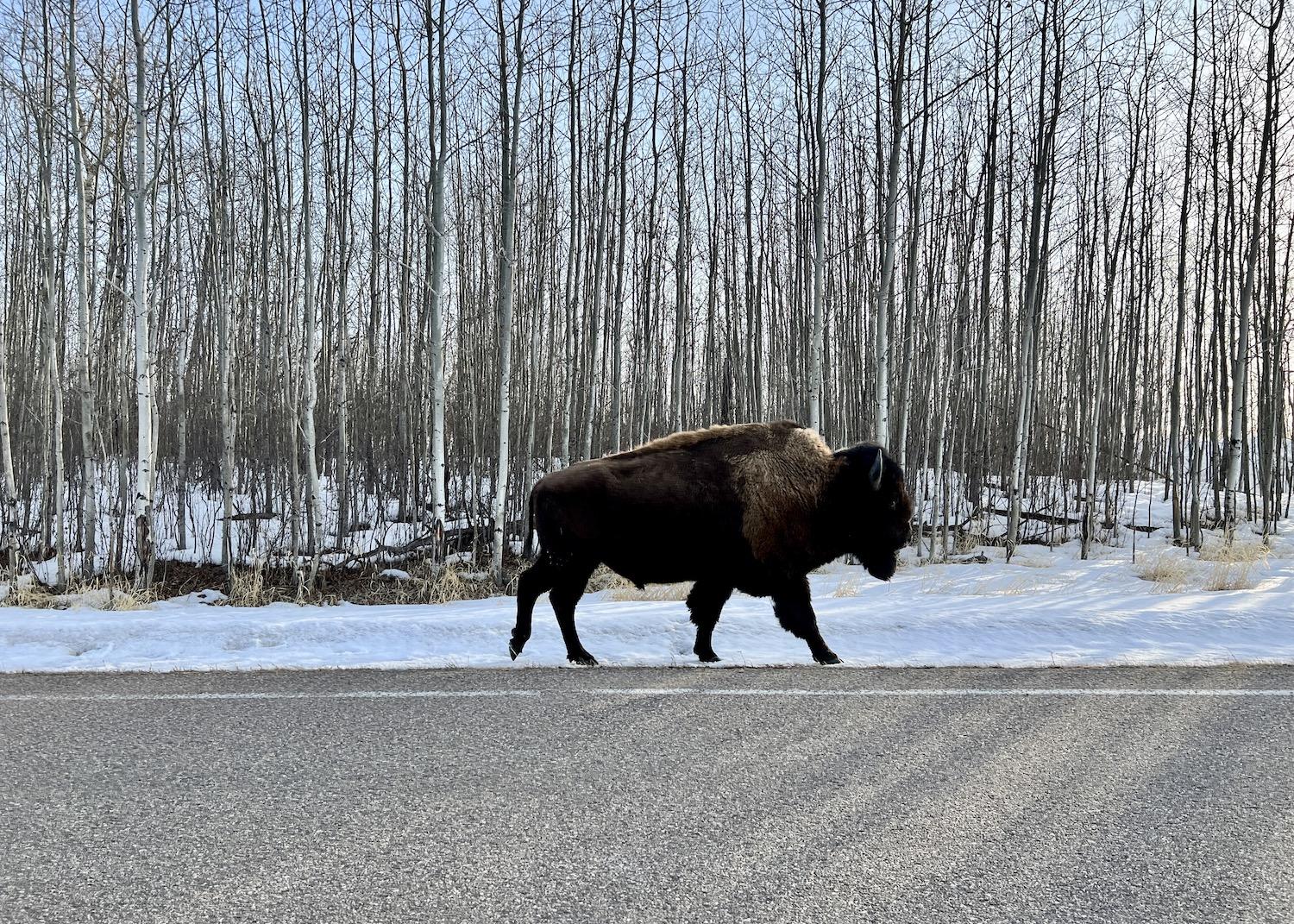
A plains bison strolls down the road on the north side of the highway in Elk Island National Park/Jennifer Bain
We aren't able to take the park's Bison Backstage Tour, but I learn that more than 3,300 of its plains and wood bison have been translocated to establish conservation herds across North America and the world.
Bison have been transferred to other national parks and numerous Indigenous communities. One of those places is Métis Crossing, a 688-acre cultural heritage gathering center owned by the Métis Nation of Alberta on historical Métis river lots overlooking the North Saskatchewan River.
Métis Crossing is just 40 minutes northeast of Elk Island and I have visited twice — last fall to stay at its 40-room lodge and this time just for an afternoon to see the bison and elk. There is a cultural center, wonderful café that serves bison sausages and burgers, gift shop and guided cultural interpretive experiences.
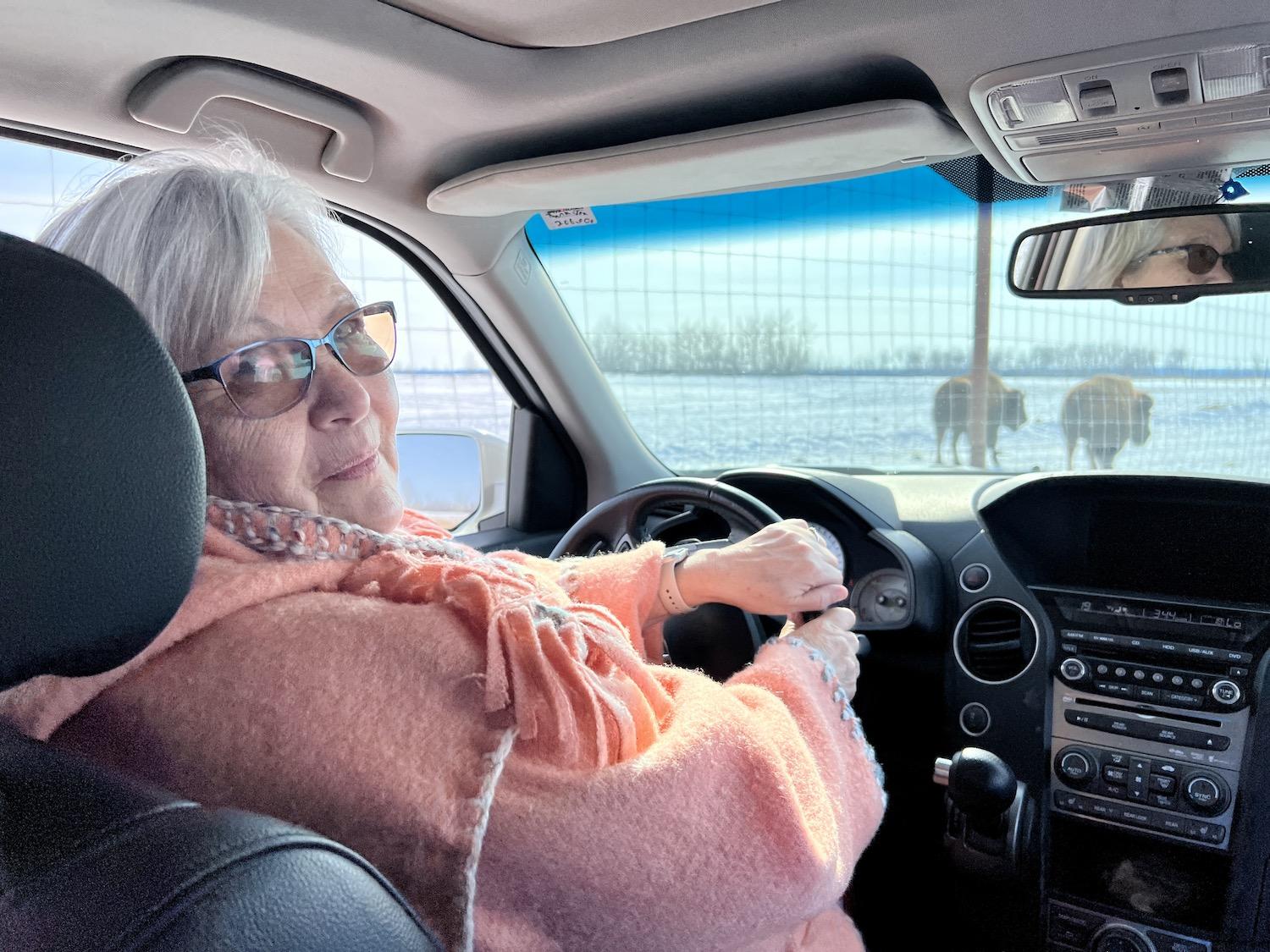
Métis elder and knowledge holder Lilyrose Meyers leads a guided tour of the Visions, Hopes and Dreams at Métis Crossing Wildlife Park/Jennifer Bain
Métis elder and knowledge holder Lilyrose Meyers takes us to the Visions, Hopes and Dreams at Métis Crossing Wildlife Park (all tours must be in a vehicle) to see Métis heritage species including white bison, wood bison, plains bison, elk (including white elk) and Percheron horses.
The bison — bufloo in Michif — last roamed these hills in 1865. Spring and fall bison hunts once brought thousands of Métis people together. When Elk Island transferred 20 wood bison to Métis Crossing in 2022, there was a blessing ceremony to welcome them and mark what was called a "milestone in reconciliation."
Métis Crossing is, as Meyers so eloquently puts it, "a place of learning and it's for all of us." Today it's also the perfect place to spend an afternoon after my morning at Elk Island with Talking Rock Tours. I think of Diakiw and his thermos of herbal tea when I spot the complimentary tea station with a note saying the Métis traditionally welcome guests with tea. And when I spot Métis sashes in the gift shop and on a wooden display loom, I remember how it felt when Diakiw unexpectedly shared this essential piece of his culture and wrapped one temporarily around my waist.
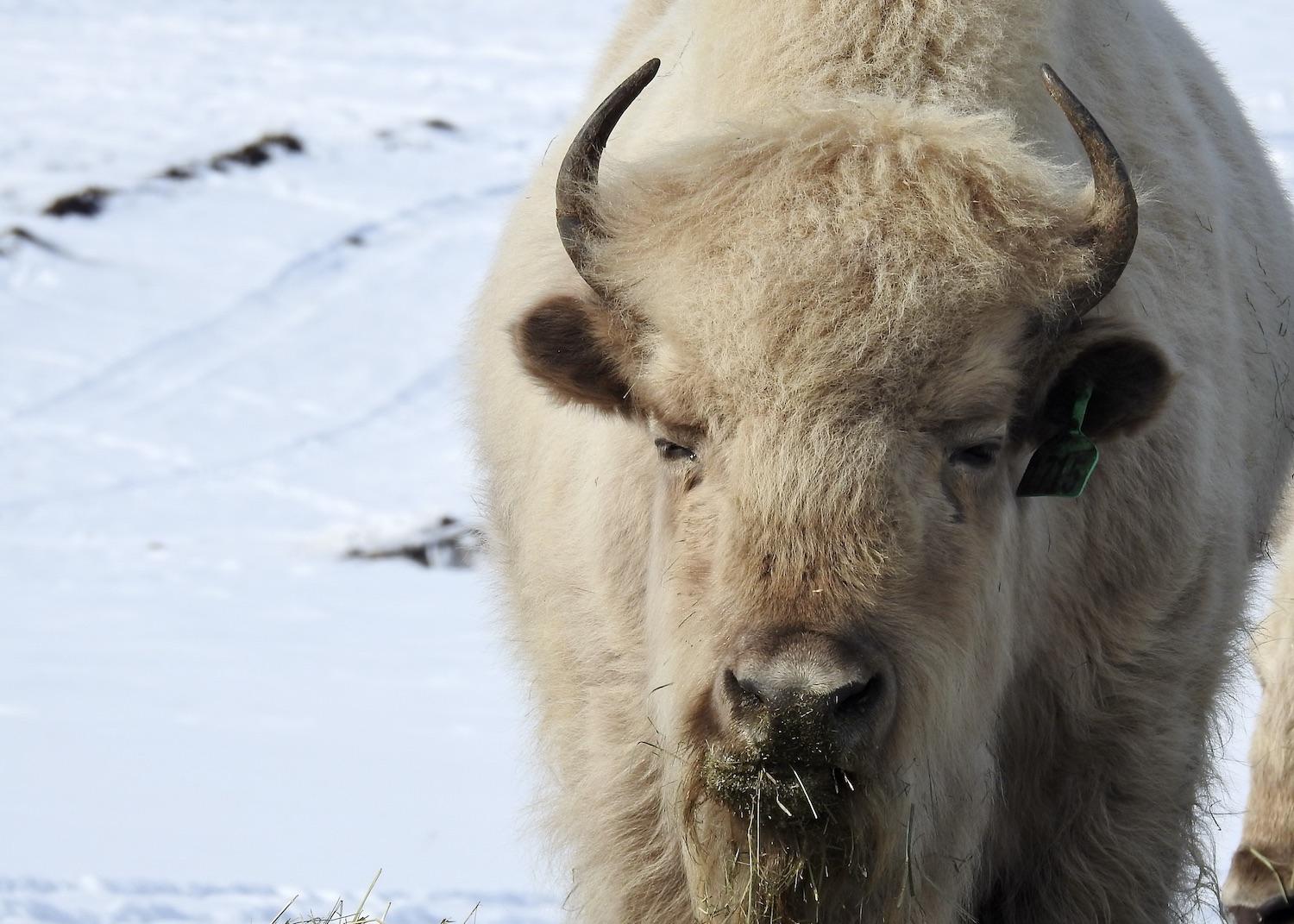
A white bison spotted during a guided tour by vehicle of the Visions, Hopes and Dreams at Métis Crossing Wildlife Park/Jennifer Bain


